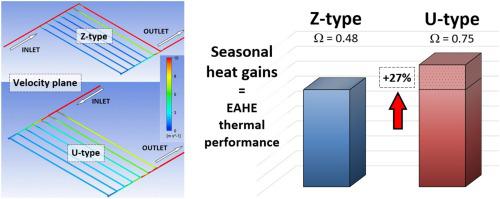当前位置:
X-MOL 学术
›
Geothermics
›
论文详情
Our official English website, www.x-mol.net, welcomes your feedback! (Note: you will need to create a separate account there.)
Thermal performance of multi-pipe earth-to-air heat exchangers considering the non-uniform distribution of air between parallel pipes
Geothermics ( IF 3.9 ) Pub Date : 2020-11-01 , DOI: 10.1016/j.geothermics.2020.101896 Łukasz Amanowicz , Janusz Wojtkowiak
Geothermics ( IF 3.9 ) Pub Date : 2020-11-01 , DOI: 10.1016/j.geothermics.2020.101896 Łukasz Amanowicz , Janusz Wojtkowiak

|
Abstract In multi-pipe structures of earth-to-air heat exchangers (EAHEs), the airflow distribution between parallel pipes is not uniform and depends on many geometrical parameters, primarily the relation between the diameters of parallel pipes and manifolds, and the length of branch pipes. The phenomenon of airflow non-uniformity is usually neglected in the thermal performance calculations. This report investigates the influence of airflow distribution patterns on the thermal performance of multi-pipe EAHEs in order to bridge this knowledge gap. The calculations have been performed for a winter-time season for exchangers located in the climatic conditions of Central Europe. Analysis was conducted for different airflow conditions characterized by an airflow distribution uniformity coefficient. Results show that the thermal performance calculated for real EAHEs, with branch-pipes of a length L = 76d and diameters equal to the main pipe diameters, can be up to 28% lower than for ideal (uniform) distribution of air in an analogous exchanger. For EAHEs with branch-pipes of a length L = 300d and main pipes 1.4 times larger in diameter than parallel branch-pipes, the differences are much lower, i.e., less than 13%. The correlation between the airflow distribution uniformity coefficient and the EAHE seasonal heat gains is presented for exchangers consisting of 3, 5, 7, or 10 parallel branch-pipes. These results can be applied in various energy and economic analyses to estimate the potential energy savings from designing energy efficient building HVAC systems equipped with EAHEs characterized by better airflow distribution.
中文翻译:

考虑平行管间空气不均匀分布的多管地气换热器热性能
摘要 在地气换热器(EAHE)的多管结构中,平行管之间的气流分布不均匀,取决于许多几何参数,主要是平行管和歧管的直径和长度之间的关系。支管。在热性能计算中通常忽略气流不均匀现象。本报告调查了气流分布模式对多管 EAHE 热性能的影响,以弥合这一知识差距。计算是针对位于中欧气候条件下的交换器的冬季季节进行的。对以气流分布均匀系数为特征的不同气流条件进行了分析。结果表明,对于实际 EAHE 计算出的热性能,支管长度为 L = 76d,直径等于主管直径,比模拟交换器中空气的理想(均匀)分布低 28% . 对于支管长度为 L = 300d 且主管直径比平行支管大 1.4 倍的 EAHE,差异要小得多,即小于 13%。对于由 3、5、7 或 10 个平行支管组成的换热器,给出了气流分布均匀系数和 EAHE 季节性热增益之间的相关性。这些结果可应用于各种能源和经济分析,以估计设计节能建筑 HVAC 系统的潜在节能,该系统配备了以更好的气流分布为特征的 EAHE。对于长度 L = 76d 且直径等于主管直径的支管,与在类似交换器中理想(均匀)分布的空气相比,最多可降低 28%。对于支管长度为 L = 300d 且主管直径比平行支管大 1.4 倍的 EAHE,差异要小得多,即小于 13%。对于由 3、5、7 或 10 个平行支管组成的换热器,给出了气流分布均匀系数和 EAHE 季节性热增益之间的相关性。这些结果可应用于各种能源和经济分析,以估计设计节能建筑 HVAC 系统的潜在节能,该系统配备了以更好的气流分布为特征的 EAHE。对于长度 L = 76d 且直径等于主管直径的支管,与在类似交换器中理想(均匀)分布的空气相比,最多可降低 28%。对于支管长度为 L = 300d 且主管直径比平行支管大 1.4 倍的 EAHE,差异要小得多,即小于 13%。对于由 3、5、7 或 10 个平行支管组成的换热器,给出了气流分布均匀系数和 EAHE 季节性热增益之间的相关性。这些结果可应用于各种能源和经济分析,以估计设计节能建筑 HVAC 系统的潜在节能,该系统配备了以更好的气流分布为特征的 EAHE。可比类似交换器中理想(均匀)的空气分布低 28%。对于支管长度为 L = 300d 且主管直径比平行支管大 1.4 倍的 EAHE,差异要小得多,即小于 13%。对于由 3、5、7 或 10 个平行支管组成的换热器,给出了气流分布均匀系数和 EAHE 季节性热增益之间的相关性。这些结果可应用于各种能源和经济分析,以估计设计节能建筑 HVAC 系统的潜在节能,该系统配备了以更好的气流分布为特征的 EAHE。可比类似交换器中理想(均匀)的空气分布低 28%。对于支管长度为 L = 300d 且主管直径比平行支管大 1.4 倍的 EAHE,差异要小得多,即小于 13%。对于由 3、5、7 或 10 个平行支管组成的换热器,给出了气流分布均匀系数和 EAHE 季节性热增益之间的相关性。这些结果可应用于各种能源和经济分析,以估计设计节能建筑 HVAC 系统的潜在节能,该系统配备了以更好的气流分布为特征的 EAHE。直径比平行支管大 4 倍,差异要小得多,即小于 13%。对于由 3、5、7 或 10 个平行支管组成的换热器,给出了气流分布均匀系数和 EAHE 季节性热增益之间的相关性。这些结果可应用于各种能源和经济分析,以估计设计节能建筑 HVAC 系统的潜在节能,该系统配备了以更好的气流分布为特征的 EAHE。直径比平行支管大 4 倍,差异要小得多,即小于 13%。对于由 3、5、7 或 10 个平行支管组成的换热器,给出了气流分布均匀系数和 EAHE 季节性热增益之间的相关性。这些结果可应用于各种能源和经济分析,以估计设计节能建筑 HVAC 系统的潜在节能,该系统配备了以更好的气流分布为特征的 EAHE。
更新日期:2020-11-01
中文翻译:

考虑平行管间空气不均匀分布的多管地气换热器热性能
摘要 在地气换热器(EAHE)的多管结构中,平行管之间的气流分布不均匀,取决于许多几何参数,主要是平行管和歧管的直径和长度之间的关系。支管。在热性能计算中通常忽略气流不均匀现象。本报告调查了气流分布模式对多管 EAHE 热性能的影响,以弥合这一知识差距。计算是针对位于中欧气候条件下的交换器的冬季季节进行的。对以气流分布均匀系数为特征的不同气流条件进行了分析。结果表明,对于实际 EAHE 计算出的热性能,支管长度为 L = 76d,直径等于主管直径,比模拟交换器中空气的理想(均匀)分布低 28% . 对于支管长度为 L = 300d 且主管直径比平行支管大 1.4 倍的 EAHE,差异要小得多,即小于 13%。对于由 3、5、7 或 10 个平行支管组成的换热器,给出了气流分布均匀系数和 EAHE 季节性热增益之间的相关性。这些结果可应用于各种能源和经济分析,以估计设计节能建筑 HVAC 系统的潜在节能,该系统配备了以更好的气流分布为特征的 EAHE。对于长度 L = 76d 且直径等于主管直径的支管,与在类似交换器中理想(均匀)分布的空气相比,最多可降低 28%。对于支管长度为 L = 300d 且主管直径比平行支管大 1.4 倍的 EAHE,差异要小得多,即小于 13%。对于由 3、5、7 或 10 个平行支管组成的换热器,给出了气流分布均匀系数和 EAHE 季节性热增益之间的相关性。这些结果可应用于各种能源和经济分析,以估计设计节能建筑 HVAC 系统的潜在节能,该系统配备了以更好的气流分布为特征的 EAHE。对于长度 L = 76d 且直径等于主管直径的支管,与在类似交换器中理想(均匀)分布的空气相比,最多可降低 28%。对于支管长度为 L = 300d 且主管直径比平行支管大 1.4 倍的 EAHE,差异要小得多,即小于 13%。对于由 3、5、7 或 10 个平行支管组成的换热器,给出了气流分布均匀系数和 EAHE 季节性热增益之间的相关性。这些结果可应用于各种能源和经济分析,以估计设计节能建筑 HVAC 系统的潜在节能,该系统配备了以更好的气流分布为特征的 EAHE。可比类似交换器中理想(均匀)的空气分布低 28%。对于支管长度为 L = 300d 且主管直径比平行支管大 1.4 倍的 EAHE,差异要小得多,即小于 13%。对于由 3、5、7 或 10 个平行支管组成的换热器,给出了气流分布均匀系数和 EAHE 季节性热增益之间的相关性。这些结果可应用于各种能源和经济分析,以估计设计节能建筑 HVAC 系统的潜在节能,该系统配备了以更好的气流分布为特征的 EAHE。可比类似交换器中理想(均匀)的空气分布低 28%。对于支管长度为 L = 300d 且主管直径比平行支管大 1.4 倍的 EAHE,差异要小得多,即小于 13%。对于由 3、5、7 或 10 个平行支管组成的换热器,给出了气流分布均匀系数和 EAHE 季节性热增益之间的相关性。这些结果可应用于各种能源和经济分析,以估计设计节能建筑 HVAC 系统的潜在节能,该系统配备了以更好的气流分布为特征的 EAHE。直径比平行支管大 4 倍,差异要小得多,即小于 13%。对于由 3、5、7 或 10 个平行支管组成的换热器,给出了气流分布均匀系数和 EAHE 季节性热增益之间的相关性。这些结果可应用于各种能源和经济分析,以估计设计节能建筑 HVAC 系统的潜在节能,该系统配备了以更好的气流分布为特征的 EAHE。直径比平行支管大 4 倍,差异要小得多,即小于 13%。对于由 3、5、7 或 10 个平行支管组成的换热器,给出了气流分布均匀系数和 EAHE 季节性热增益之间的相关性。这些结果可应用于各种能源和经济分析,以估计设计节能建筑 HVAC 系统的潜在节能,该系统配备了以更好的气流分布为特征的 EAHE。



























 京公网安备 11010802027423号
京公网安备 11010802027423号